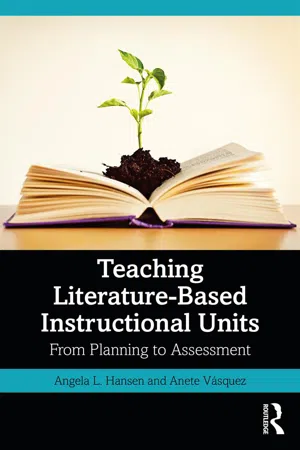
Teaching Literature-Based Instructional Units
From Planning to Assessment
- 220 pages
- English
- ePUB (mobile friendly)
- Available on iOS & Android
Teaching Literature-Based Instructional Units
From Planning to Assessment
About This Book
Teaching Literature-Based Instructional Units: From Planning to Assessment provides an accessible roadmap to planning, designing, and implementing literature-based instructional units for the English Language arts (ELA) classroom. Understanding that unit plans are the building blocks of the ELA curriculum, Hansen and Vásquez outline the theoretical foundations and approaches behind teaching ELA and offer a framework to help readers make sound decisions about their content pedagogy. In so doing, this text offers research-based and straightforward guidance on planning instruction around key literary texts. Placing literature at the center of the ELA curriculum, the approaches in this book not only support students' reading, writing, listening, speaking, and digital media skills, but will also motivate and inspire them.
Part 1 addresses how to choose unit themes and texts, discusses the importance of having a rationale for choices made, and examines the practical, philosophical, and historical approaches to teaching literature. Part 2 provides step-by-step instructions for designing literature-based units of instruction by using backwards design. The text focuses on assessment before moving into how to scaffold and sequence lessons to meet learning objectives, and concludes with consideration given to teaching ELA in virtual environments. The wealth of activities, strategies, exercises, examples, and templates in this book make this text essential reading for instructors and pre-service teachers in ELA pedagogical methods courses and for practicing teachers of literature instruction.
Frequently asked questions
Information
Section II Designing the Unit of Instruction
NCTE Standards for Initial Preparation of Teachers of Secondary English Language Arts, Grades 7–12
edTPA: Secondary English-Language Arts
5 Aims and Assessments for Literature-Based Units of Instruction
Backward design may be thought of as purposeful task analysis: Given a task to be accomplished, how do we get there? Or one might call it planned coaching: What kinds of lessons and practices are needed to master key performances? The approach to curricular design we are advocating is logically forward and commonsensical but backward in terms of conventional habits, whereby teachers typically think in terms of a series of activities…or how best to cover a topic…This backward approach to curricular design also departs from another common practice: thinking about assessment as something we do at the end, once teaching is completed. Rather than creating assessments near the conclusion of a unit of study (or relying on the tests provided by textbook publishers, which may not completely or appropriately assess our standards), backward design calls for us to operationalize our goals or standards in terms of assessment evidence as we begin to plan a unit or course. It reminds us to begin with the question: What would we accept as evidence that students have attained the desired understandings and proficiencies—before proceeding to plan teaching and learning experiences?(p. 8)
Unit Goals
- What can my students learn about the English language arts and literature through this unit?
- What do I want my students to know and be able to do through the study of literature?
- What reading skills and processes do I want to emphasize in this unit of study?
- What writing skills and processes do I want to emphasize in this unit of study?
- What language skills do I want to emphasize including grammar, vocabulary, and language study?
- What listening and speaking skills do I want to emphasize in this unit of study?
- What skills do I want to emphasize related t...
Table of contents
- Cover
- Half Title
- Title Page
- Copyright Page
- Dedication
- Contents
- List of Figures
- List of Tables
- Acknowledgements
- Author Biographies
- Introduction
- Section I: Approaching the Literature-Based Unit of Instruction
- Section II: Designing the Unit of Instruction
- Conclusion
- Index